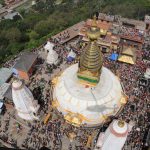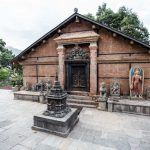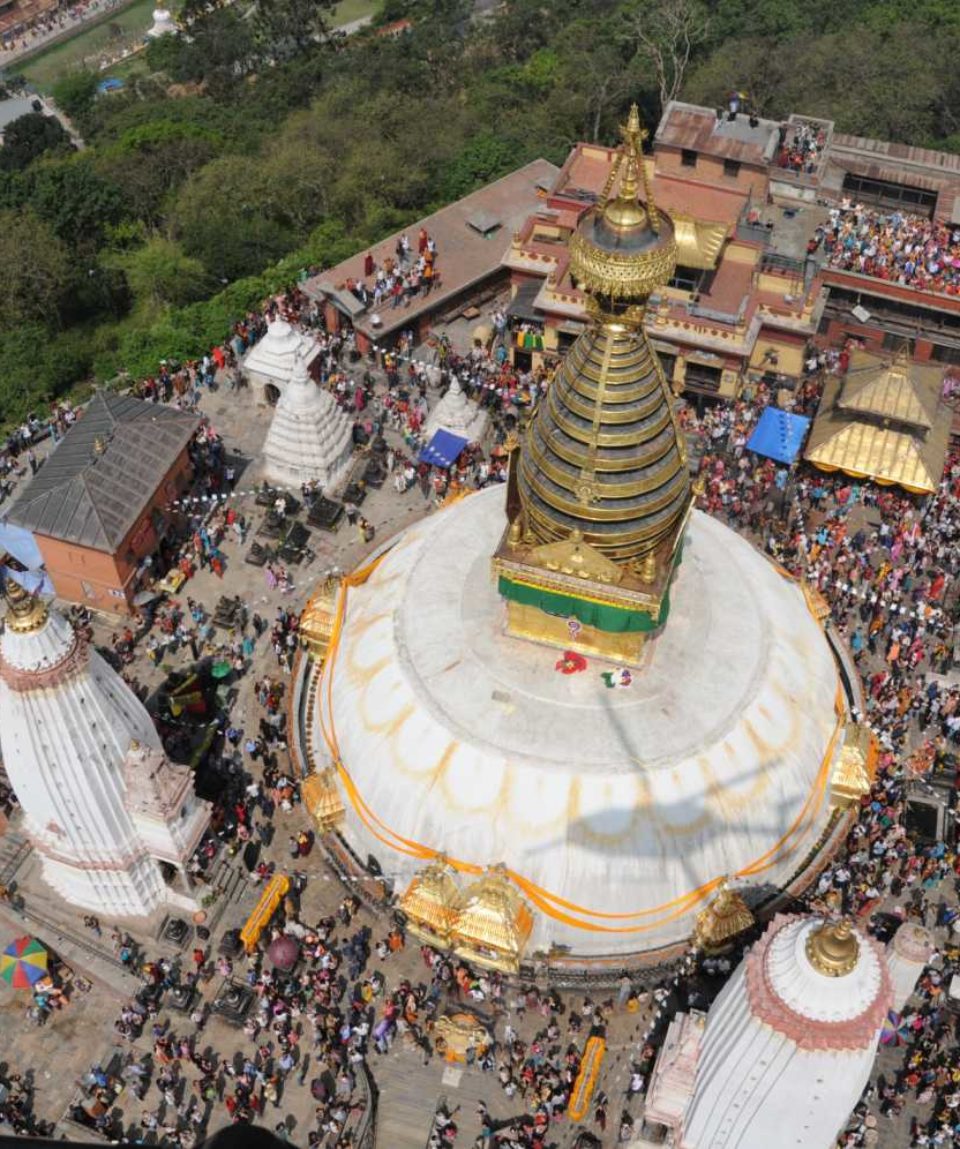Swayambhunath Day Tour
fromTo enter Swayambhunath, we have two entrances. The main entrance is near the parking lot which has a few stone steps while the other entrance has 365 stone steps. If you choose to climb the 365 stone steps, you can see a lot of monkeys which will justify the reason for calling Swayambhunath – The Monkey Temple. However, the main reason for calling it the monkey temple is based on a legend that says when Manjushree, the bodhisattva of wisdom and learning, was creating the hill on which the temple stands, the lice from his hair transformed into monkeys that inhabit the temple to this day. So, the legend suggests the nickname is a way of showing tribute.
-
Reviews 0 Reviews0/5
-
Vacation Style Holiday Type
-
Activity Level Fairly Easy
-
Group Size Medium Group
After walking through the entrance, we will reach the main Swayambhunath Stupa. But before that, we will witness the Vajra.
The Vajra (Lightning Bolt)
The enormous vajra, or lightning bolt, perched atop a Mandala with animals depicted at its base, will be visible just before we reach the top of the steps and the majestic stupa comes into view.

The Main Swayambhu Stupa
The Vajra stands right ahead of the main stupa.
The Swayambhunath stupa’s design is very symbolic. The stupa’s canopy, which is located at its summit, stands for enlightenment. The thirteen golden disks on the gilded spire represent the 13 steps necessary to reach full enlightenment. In 2010, the stupa underwent a renovation, and 20kg of gold was used to refinish the spire. The Buddha’s two eyes, which can view from all four directions, are visible. The nose, which resembles a question mark and is designated as Nepali number 1 (Ek), stands for the unity of all things. The earth is symbolized by the whitewashed dome.
(A written testament says that at the start of the fifth century, King Varsadeva constructed a temple here. Additionally, a broken stone tablet found there attests to King Manadeva’s having had construction done there in 640 AD.)
The statues of the Five Dhyani Buddhas are arranged around the stupa’s base in four distinct directions. They are Akshobhya (water), Ratnasambhava (earth), Amitabha (fire), Amoghasiddhi (air), and Vairocana (ether), which stand for the five cosmic elements (earth, water, ether, air, and fire) and their consorts.
Swayambhu Buddhist Museum
We will proceed from the great stupa to a modest red brick structure that contains the dimly illuminated museum. A modest collection of Buddhist sculptures and other artifacts have been accumulated inside the stupa throughout the years. Entry is uncompensated.
 Hariti Temple (Ajima Temple)
Hariti Temple (Ajima Temple)
The Hariti Temple, a stunning two-tiered Newari-style temple with gold trim, is located close to the museum. In front of the temple where the shrine is, photography is prohibited. You may, however, take pictures of the temple from the side or the back.
There is frequently a crowd at the Hariti Temple, one of Kathmandu’s most visited sites. The smallpox goddess Hariti sends both the illness and its remedy to children. For the time being, it’s crucial to understand that smallpox once devastated Kathmandu, wreaking havoc on everyone from the very poor to the aristocracy.
 Shakyamuni Buddha (Dīpankara Buddha)
Shakyamuni Buddha (Dīpankara Buddha)
The Shakyamuni Buddha, a black stone carving of Buddha towering tall and huge, is located behind the Hariti Temple. There is nothing else in Nepal like it, and it was carved from a single piece of stone sometime in the 7th century. It is claimed that Siddhartha Gautama is depicted in the artwork.
Before heading to our next destination, Shantipur, we will stop by some restaurants and have some food (of your choice!). We know that you must have some “I am going to try this once I land in Nepal” dishes.
 Shantipur (Sky Element)
Shantipur (Sky Element)
Some of Nepal’s most well-known stories are housed in the newly constructed structure to the north of Swayambhu. Originally intended for the sky god, it was constructed more than 1500 years ago. But Shantikaracharya, a Vajrayana priest, gave it its present name. It is said that Shantikaracharya attained so great power that he was able to control gods, spirits, and spells. He is also credited with defeating death. He momentarily emerged from the third underground room where he had sealed himself when King Gunakamadeva begged the priest to assist with the drought.
The priest emerged from the city carrying Nagas, and water was distributed once more. Later, King Pratap Malla went into the temple’s underground rooms in search of assistance. The priest was there, appearing free yet alive. The king brought a scroll outside and it started to rain as Shantikaracharya pointed to a Mandala on the parchment. The monarch was so ecstatic about it that he inscribed a sonnet about it inside the structure.
Stupas Around Swayambhu
A bell, the global peace pond, and a group of lesser stupas can be found down a flight of stairs from Shantipur. A little woodland can be found behind the pond. The side entrance to the stupa complex is located across from the world peace pond. We shall go to the Natural History Museum, where the history of Buddhism and Swayambhu is kept, from the World Peace Pond. Here, we will have the chance to learn about the historical influences that have influenced Kathmandu and Nepal.
Likewise, after seeing those tiny stupas, we will proceed to Wochen Thokjay Choeling Monastery, which is just a little distance up the hill. We will also spend some time in Buddha Park, which is home to several stunning huge Buddha statues before our tour comes to a close.








